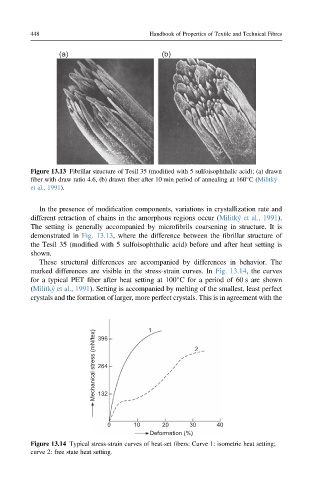Page 475 - Handbook of Properties of Textile and Technical Fibres
P. 475
448 Handbook of Properties of Textile and Technical Fibres
(a) (b)
Figure 13.13 Fibrillar structure of Tesil 35 (modified with 5 sulfoisophthalic acid); (a) drawn
fiber with draw ratio 4.6, (b) drawn fiber after 10 min period of annealing at 160 C(Militký
et al., 1991).
In the presence of modification components, variations in crystallization rate and
different retraction of chains in the amorphous regions occur (Militký et al., 1991).
The setting is generally accompanied by microfibrils coarsening in structure. It is
demonstrated in Fig. 13.13, where the difference between the fibrillar structure of
the Tesil 35 (modified with 5 sulfoisophthalic acid) before and after heat setting is
shown.
These structural differences are accompanied by differences in behavior. The
marked differences are visible in the stress-strain curves. In Fig. 13.14, the curves
for a typical PET fiber after heat setting at 100 C for a period of 60 s are shown
(Militký et al., 1991). Setting is accompanied by melting of the smallest, least perfect
crystals and the formation of larger, more perfect crystals. This is in agreement with the
1
Mechanical stress (mN/tex) 396 2
264
132
0 10 20 30 40
Deformation (%)
Figure 13.14 Typical stress-strain curves of heat-set fibers: Curve 1: isometric heat setting;
curve 2: free state heat setting.

